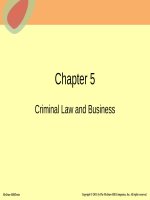- Trang chủ >>
- Thạc sĩ - Cao học >>
- Luật
Lecture Dynamic business law, the essentials (2/e) - Chapter 2: The U.S. legal system and alternative dispute resolution
Bạn đang xem bản rút gọn của tài liệu. Xem và tải ngay bản đầy đủ của tài liệu tại đây (230.5 KB, 24 trang )
Chapter 2
The U.S. Legal System and
Alternative Dispute Resolution
McGrawHill/Irwin
Copyright © 2013 by The McGrawHill Companies, Inc. All rights reserved.
Types of Jurisdiction
• Original Jurisdiction:
The power to hear
and decide cases
when they first enter
the legal system
• Appellate Jurisdiction:
The power to review
previous judicial
decisions to
determine whether
trial courts erred in
their decisions
22
Types of Jurisdiction
• In personam
jurisdiction: The
power to render a
decision affecting the
rights of the specific
persons before the
court
• Subject-matter
jurisdiction: The
power to hear certain
kinds of cases
23
Subject-Matter Jurisdiction:
Exclusive Federal Jurisdiction
•
•
•
•
Admiralty cases
Bankruptcy cases
Federal criminal prosecutions
Cases in which one state sues another
state
• Claims against the United States
• Federal patent, trademark, and copyright
claims
• Other claims involving federal statutes that
specify exclusive federal jurisdiction
24
Subject-Matter Jurisdiction:
State Jurisdiction
• All cases not falling under
Exclusive Federal Jurisdiction
25
Subject-Matter Jurisdiction:
Concurrent Federal and State
Jurisdiction
• Federal question cases
• Diversity of citizenship cases
26
The Federal Court System
• The United States Supreme
Court
• Intermediate Courts of Appeal
• Federal Trial Courts (U.S.
District Courts)
27
State Court Systems
• State Supreme Courts
• Intermediate Courts of Appeal
• State Trial Courts
28
Threshold Requirements for Litigation
• Standing (to sue)
-Actual/imminent injury in fact
-Injury traceable to actions of defendant
-Injury redressed by favorable decision
• Case or Controversy (Justifiable Controversy)
-Adverse relationship between plaintiff and
defendant
-Actions of one party give rise to legal dispute
-Court decision able to resolve dispute
• Ripeness
-Decision able to affect parties immediately
29
Steps in Civil Litigation:
The Pretrial Stage
•
•
•
•
•
•
•
Informal Negotiations
Pleadings
Service of Process
Defendant’s Response
Pretrial Motions
Discovery
Pretrial Conference
210
Steps in Civil Litigation:
The Trial
• Jury Selection
• Opening Statements
• Examination of Witnesses and
Presentation of Evidence
• Closing Arguments
• Jury Instructions
211
Steps in Civil Litigation:
Post-Trial Motions
• Motion For Judgment In
Accordance With Verdict
• Motion For Judgment
Notwithstanding Verdict
• Motion For New Trial
212
Steps in Civil Litigation:
Appellate Procedure
213
Appellate Court Decision-Making
Powers
• Affirmation
• Modification
• Reversal
• Remand
214
Alternative Dispute Resolution
215
Alternative Dispute Resolution
Definition: The resolution of legal disputes
through methods other than litigation, such
as negotiation, mediation, arbitration,
summary jury trials, mini-trials, neutral
case evaluations, and private trials
216
Reasons A Business Might Prefer
Alternative Dispute Resolution (ADR)
Versus Litigation
• ADR methods are generally faster and
less expensive than litigation
• Business may wish to avoid uncertainty
associated with a jury decision
• Business may wish to avoid setting
precedent through court decision
• Business may prefer confidential nature
of ADR
217
Primary Forms of Alternative
Dispute Resolution
• Negotiation
• Mediation
• Arbitration
218
Advantages of Mediation
• Helps disputing parties preserve their
professional relationships
• Provides possibility of finding creative
solutions to dispute
• Offers participants high level of
autonomy
219
Disadvantages of Mediation
• Appears to be an equal process and
solution, thereby hiding power imbalances
that would lead to the party with greater
power securing an agreement of greater
benefit
• Some enter mediation with no intention of
finding a solution, and use mediation as a
delay tactic
220
Advantages of Arbitration
• More efficient and less expensive than litigation
• Parties have more control over the process of
dispute resolution (parties choose the arbitrator
and determine how formal the process will be)
• Parties can choose arbitrator with expertise in
specific subject matter of dispute
• Arbitrator has greater flexibility in decision-making
(compared to decision-making authority of judge)
221
Disadvantages of Arbitration
• As use of arbitration increases, efficiencies
and lower cost advantages (compared to
litigation) decrease
• Difficulty of appealing an arbitration award
• Loss of civil rights and remedies available
through litigation
• Companies and employers may effectively
“hide” their disputes through arbitration (nonpublic nature of arbitration versus public trial)
222
Binding Arbitration Clause
Definition: A provision in a contract
mandating that all disputes arising under
a contract must be settled by arbitration
223
Other Alternative Dispute
Resolution Methods
•
•
•
•
•
Mediation-Arbitration (“Med-Arb”)
Summary Jury Trial
Mini-Trial
Early Neutral Case Evaluation
Private Trials
224









